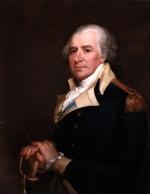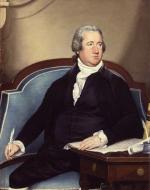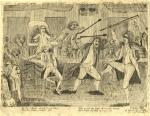![header=[Marker Text] body=[Member of the Continental Congress, a Revolutionary soldier, first Pennsylvania governor, 1790-99, lived at his estate Angelica from 1774 to 1794. The Berks County Farm and Home now occupies the site. ] sign](http://explorepahistory.com/kora/files/1/10/1-A-27E-139-ExplorePAHistory-a0h9a1-a_450.jpg)
Mouse over for marker text
Name:
Thomas Mifflin [New Nation]
Region:
Hershey/Gettysburg/Dutch Country Region
County:
Berks
Marker Location:
U.S. 222 (E. Lancaster Ave.) at Mifflin Blvd., Shillington
Dedication Date:
March 27, 1947
Behind the Marker
"Anglo-maniacs" versus "Jacobins." That is what the 1790s would look like politically if we believed what the Federalists and their Republican opponents said about each other. The 1790s saw some of the fiercest political battles in American history, mostly fought by men who had united to support the new Constitution in 1787. They argued over foreign and domestic policy.
One source of division was a national bank, which the Federalists hoped would strengthen the federal government and turn the United States in a more industrial and commercial direction. Chartered by Congress in 1791, the Bank of the United States loaned the federal government millions of dollars to pay off the debt incurred by the Revolutionary War, and quickly won the animosity of Republicans, who believed that its conservative lending policies and loans to wealthy Americans and foreigners were part of a Federalist plot to replace a republic with an aristocracy.
The two sides also argued over whether to support the democratic French Revolution, embraced by the Republicans, or the new nation's main trading partner Great Britain, preferred by the Federalists. Each party came to consider the other a tool of the foreign government it favored; hence the terms "Anglomaniac" and "Jacobin," the name given to the radical French revolutionaries who instituted the Reign of Terror.
Angry partisan divisions spilled over into the states, especially Pennsylvania, where the two parties were closely divided, and centered in Philadelphia, the nation's capitol from 1790 to 1800, and its largest city. The nation's two strongest protests against new taxes, which the Federalists called the "Whiskey Rebellion" and "Fries" Rebellion" both occurred in Pennsylvania. The protestors never did intend to overthrow the government, but the names have stuck.
"Fries" Rebellion" both occurred in Pennsylvania. The protestors never did intend to overthrow the government, but the names have stuck.
In this setting, it is almost incredible that Pennsylvania voters elected Thomas Mifflin by overwhelming margins as governor for the three terms allowed by the new state Constitution of 1790. He defeated Arthur St. Clair by 27,725 votes to 2,802 in 1790; Frederick A. Muhlenberg by 18,590 to 10,706 in 1793; and Muhlenberg again by 30,020 to 1,011 in 1796. So how did he do it?
Arthur St. Clair by 27,725 votes to 2,802 in 1790; Frederick A. Muhlenberg by 18,590 to 10,706 in 1793; and Muhlenberg again by 30,020 to 1,011 in 1796. So how did he do it?
Holding firm to the notion that the American experiment in self-government would work best without the warring presence of "factions" or political parties, Mifflin became neither a Federalist nor a Republican. Although the two sides were acting like political parties by running candidates, they did not really understand what they were doing. Each considered the other a faction that was trying to overthrow the republic rather than a legitimate competitor, as the Democrats and Republicans do today.
Mifflin, however, was his own man. When it came to appoint judges and public officials, he chose both Federalists and Republicans. His chief advisor, Alexander Dallas, was a strong Republican. As the nation and Pennsylvania became more partisan in the 1790s, Mifflin became less so. In 1793 he approved the Pennsylvania legislature's decision to send troops to remove reluctant Indians from the Erie Triangle, the land on the shore of Lake Erie they had purchased from Indian leaders - who did not represent the entire population - to give the state a port on the Great Lakes. But he withheld the troops after President Washington told him they would needlessly provoke a frontier war.
Erie Triangle, the land on the shore of Lake Erie they had purchased from Indian leaders - who did not represent the entire population - to give the state a port on the Great Lakes. But he withheld the troops after President Washington told him they would needlessly provoke a frontier war.
In 1793, Mifflin also welcomed "Citizen Edmond Genet" to Philadelphia as the French Revolutionary minister, which pleased the Republicans, but changed his mind when Genet compromised American neutrality by outfitting a privateer in Philadelphia to attack British ships, which pleased the Federalists. The following year, Mifflin refused Washington's request that Pennsylvania raise the state militia to put down the Whiskey Rebellion in western Pennsylvania, to the applause of Republicans, but when Washington took the field to suppress the rebellion, Mifflin not only supported him with vigor but accompanied the troops, an action praised by the Federalists. In 1798, he supported Federalist President John Adams' advocacy of naval preparedness against French warships attacking American ships. But then Mifflin opposed the Alien and Sedition Acts, which the Federalist-controlled Congress had passed to criminalize criticisms of the federal government.
Mifflin unfortunately turned to drink in the later 1790s. The elder statesman was elected to the state assembly following his governorship. By then, however, his finances were as muddled as his personal life. Bankrupt, he died in 1800 and was buried at state expense. This was a tragic ending for a man who had put principle above politics. In the 1790s, a time when the new nation's very survival was at stake, Mifflin had helped hold Pennsylvania together through two rebellions and bitter political divisions.
One source of division was a national bank, which the Federalists hoped would strengthen the federal government and turn the United States in a more industrial and commercial direction. Chartered by Congress in 1791, the Bank of the United States loaned the federal government millions of dollars to pay off the debt incurred by the Revolutionary War, and quickly won the animosity of Republicans, who believed that its conservative lending policies and loans to wealthy Americans and foreigners were part of a Federalist plot to replace a republic with an aristocracy.
The two sides also argued over whether to support the democratic French Revolution, embraced by the Republicans, or the new nation's main trading partner Great Britain, preferred by the Federalists. Each party came to consider the other a tool of the foreign government it favored; hence the terms "Anglomaniac" and "Jacobin," the name given to the radical French revolutionaries who instituted the Reign of Terror.
Angry partisan divisions spilled over into the states, especially Pennsylvania, where the two parties were closely divided, and centered in Philadelphia, the nation's capitol from 1790 to 1800, and its largest city. The nation's two strongest protests against new taxes, which the Federalists called the "Whiskey Rebellion" and
In this setting, it is almost incredible that Pennsylvania voters elected Thomas Mifflin by overwhelming margins as governor for the three terms allowed by the new state Constitution of 1790. He defeated
Holding firm to the notion that the American experiment in self-government would work best without the warring presence of "factions" or political parties, Mifflin became neither a Federalist nor a Republican. Although the two sides were acting like political parties by running candidates, they did not really understand what they were doing. Each considered the other a faction that was trying to overthrow the republic rather than a legitimate competitor, as the Democrats and Republicans do today.
Mifflin, however, was his own man. When it came to appoint judges and public officials, he chose both Federalists and Republicans. His chief advisor, Alexander Dallas, was a strong Republican. As the nation and Pennsylvania became more partisan in the 1790s, Mifflin became less so. In 1793 he approved the Pennsylvania legislature's decision to send troops to remove reluctant Indians from the
In 1793, Mifflin also welcomed "Citizen Edmond Genet" to Philadelphia as the French Revolutionary minister, which pleased the Republicans, but changed his mind when Genet compromised American neutrality by outfitting a privateer in Philadelphia to attack British ships, which pleased the Federalists. The following year, Mifflin refused Washington's request that Pennsylvania raise the state militia to put down the Whiskey Rebellion in western Pennsylvania, to the applause of Republicans, but when Washington took the field to suppress the rebellion, Mifflin not only supported him with vigor but accompanied the troops, an action praised by the Federalists. In 1798, he supported Federalist President John Adams' advocacy of naval preparedness against French warships attacking American ships. But then Mifflin opposed the Alien and Sedition Acts, which the Federalist-controlled Congress had passed to criminalize criticisms of the federal government.
Mifflin unfortunately turned to drink in the later 1790s. The elder statesman was elected to the state assembly following his governorship. By then, however, his finances were as muddled as his personal life. Bankrupt, he died in 1800 and was buried at state expense. This was a tragic ending for a man who had put principle above politics. In the 1790s, a time when the new nation's very survival was at stake, Mifflin had helped hold Pennsylvania together through two rebellions and bitter political divisions.
Beyond the Marker







